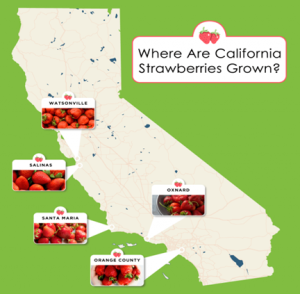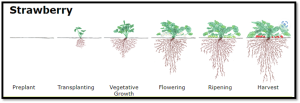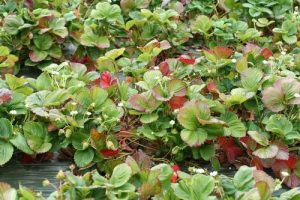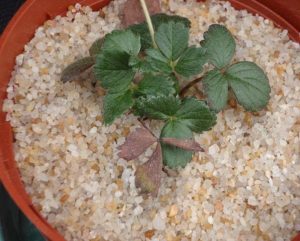Strawberry yields have been higher in California than most other parts of the U.S. since the early 1950s. Strawberries are a high-value, highly perishable fruit, and as such, the industry developed around large populations such as Los Angeles and Orange counties, near San Francisco and Sacramento, and the San Joaquin Valley where the berries could easily be distributed. The mild climate allows for strawberry harvests to extend over a long period of time (April until November). In recent years, with a multitude of early varieties, the harvest has begun as early as late January.
After World War II, strawberry production in California increased rapidly. This allowed the Salinas Valley to become the largest commercial strawberry producing area in the world, with successful production and marketing of frozen strawberries being a primary factor in California’s dominance. Strawberry production acreage continues to grow each year, with fresh strawberries being 75% of the production and the other 25% being frozen and processed berries. Currently, Watsonville, Salinas, Santa Maria, Oxnard and Orange County contain the most strawberry acreage in production (Figure 1). Growth stages of strawberry plants are illustrated in Figure 2, ranging from preplant to harvest.

Preseason
Prior to the strawberry growing season, it is always important to take a representative soil test to determine soil type, electrical conductivity (ECe), pH, cation exchange capacity (CEC), quantity of exchangeable cations and organic matter content. Local labs provide this service and can be contracted to take samples, run tests and provide recommendations to growers. Here is where the CCA training comes into play. Knowing the types of nutrients essential for plant growth and in what quantities is an important skill acquired through CCA stewardship. Similarly, you will want to request laboratory tests for nitrate (NO3-N), dissolved solids, salts, bicarbonates, pH and ECe for the irrigation water that will be applied to the crop during the season.

Many growers use preplant applications of fertilizer applied at bed shaping to ensure the newly transplanted plants have adequate nutrients. Controlled/slow-release fertilizers release nutrients gradually into the soil as the plant needs them as opposed to conventional fertilizers which are available immediately upon application. The timing of preplant applications is important as studies have shown most of the nitrogen (N) applied at preplant was released before the plants were large enough to utilize the available N. Phosphorus (P) and potassium (K) are much less mobile than N and are better utilized when applied during bed shaping.
At Planting
At planting, it is essential to maintain a large enough reservoir of exchangeable N, P and K within the soil to allow for optimal growth of the newly transplanted strawberry plant. The young plants have a limited root system and will not require large amounts of nutrients at this point in the season. A soil test value for nitrate developed by T.K. Hartz shows that a value of 20 mg/L is adequate to supply NO3-N to the young plant. Phosphorus is an essential element in plants as it is a component of nucleic acids (Deoxyribonucleic acid (DNA) and ribonucleic acid (RNA)), energy-containing molecules (adenosine triphosphate (ATP)) and nicotinamide adenine dinucleotide phosphate (NADP)) and cell structure (phospholipids). Phosphorus availability is essential for root growth and cell multiplication as the new transplants take root in the soil. Mycorrhizal fungi applications have been shown to increase phosphorus supply to the plants through a symbiotic relationship where the plant essentially trades sugars for phosphorus. This is of course a very complex process and not as simple as it sounds.

Early Season
As the season progresses and the strawberry plants grow larger, a continuous supply of N, P and K must be maintained. While the plant is still in a vegetative state, additions of N need to be monitored closely. Not enough N and the plant will show deficiency symptoms similar to (Figure 3). If not enough N is applied, the canopy will not grow large enough to protect the fruit from the sun. Too much N and the plant will continue vegetative growth and continue to produce leaves and only small fruit. If the canopy is too large, more nutrients are required to maintain the plant’s structure and the plant will have a difficult time providing adequate-sized fruit for harvest.
Phosphorus applications are essential to allow for crown split, which aids in the determination of the plant’s berry production. Phosphorus deficiency in strawberries begins with a slight purple discoloration which can be mistaken for twospotted spider mite infestation, so monitoring and tissue testing is critical. As the P deficiency progresses, we see reddening of the lower leaves (Figure 4). The crown of the strawberry plant is the short, thick stem which has many growing points slightly above the ground. It is the base of the plant from which leaves, fruit, runners and roots all grow. The more crowns, the more potential berries. Potassium is also essential as it controls stomatal apertures and allows the plant to regulate the transpiration occurring.

Mid to Peak Season
As flowers begin to develop and the plants move out of vegetative growth, it is important to continue to supply N, P and K in larger quantities. Flower and fruit development will require P for cell multiplication and energy as the fruit develops rapidly. Phosphorus will also be important to plants for continued root growth as well as inducing new flowers to be produced within the crown. Calcium (Ca) concentrations available to the plants become more important as the cell wall strength of fruit relies heavily on both Ca and K to provide firmness of the strawberry fruit. A significant portion of the fertilizer budget for the season is taken up by the plants from April to mid-September, reaching approximately 1 lb N/acre per day. This can be used to determine rough application rates of N, but keep in mind that the plant is only one of the intermediate destinations of nutrients in the soil. Microbial populations can take nutrients into their biomass, essentially removing them temporarily from the available nutrient pool. In addition, exchange sites on soil particles and organic matter can further limit nutrient availability. A more descriptive guideline for fertilization of California strawberries can be found at Geisseler.ucdavis.edu/Guidelines/Strawberry.html, which is a collaboration between California Department of Food and Agriculture (CDFA), the Fertilizer Research and Education Program (FREP) and UC Davis. Be advised that a routine soil test such as a saturated paste extract is a good reference point for an in-season fertilizer assessment but will require interpretation on a field-by-field basis. Similarly, routine tissue testing is essential to ensure optimal uptake of macronutrients and micronutrients.
Late Season
As the season progresses and fruit is harvested from the field, N, K and Ca become more essential to functions like stomatal opening and firmness of the fruit. As the plant ages and the season progresses, more salt builds up near roots, the plant is much larger than at the beginning of the season and environmental conditions such as wind and sun take a toll on the plant. Additions of potassium and some seaweeds have shown to aid the stress of the plant. Ca additions keep cell walls from become weak and flaccid. Monitoring of harvest speeds toward the end of the season is used to ensure profitability of strawberry production, especially as quality of fruit declines and diseases such as botrytis and mildew increase.
Overall, every season has its highs and lows, booms and busts in the market and environmental effects that are out of a grower’s control. The aspects that must be focused on are timely and efficient applications of the correct nutrients and pesticides, from the right source, with the right quantities at the correct growth period (right nutrient sources, right rate, right place, right time).

















